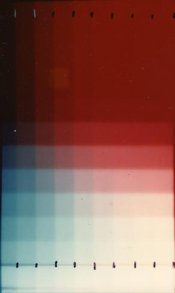Ed_Nyari
Member
- Joined
- Jun 13, 2007
- Messages
- 19
- Format
- Medium Format
Hi there
I bought a nice scientific article by Kodak engineers from 1952.
They studied interimage effects in old Ektachrome type B film.
Now I'm trying to figure out which film was that.
Tungsten from 1952. I'd assume the ASA rating was about 12-16 , but who knows.
So does anyone have any idea of what kind of Ektachrome films there were back then.
I'd settle for a rough estimate of speed, so just shoot the lowest ISO you ever heard for Ektachrome, and what year was it.
The film is sheet film, so it's either original E process or E3.
Since it's 1952. I'd bet it's original Ektachrome process.
I'm kind of currious also, how did these images look like.
Has anyone actually seen such an old corrected Ektachrome image that hasn't faded beyond uncorrectability?
The curves in the article suggest it had a much lower density range
than modern E6, or even Ektachrome 25.
The blacks must have looked a little thin, and judging by the curve, the whites looked pretty dirty too.
What is interesting is that the slope of the straight portion is milder than of modern films, and it has a GIANT toe and sholder, nothing like new films.
So the straight portion is way shorter.
I actually overlayed a modern film curve over this one (stretched the graph to precisely match desnity and exposure scales) and the difference is pretty big.
I bought a nice scientific article by Kodak engineers from 1952.
They studied interimage effects in old Ektachrome type B film.
Now I'm trying to figure out which film was that.
Tungsten from 1952. I'd assume the ASA rating was about 12-16 , but who knows.
So does anyone have any idea of what kind of Ektachrome films there were back then.
I'd settle for a rough estimate of speed, so just shoot the lowest ISO you ever heard for Ektachrome, and what year was it.
The film is sheet film, so it's either original E process or E3.
Since it's 1952. I'd bet it's original Ektachrome process.
I'm kind of currious also, how did these images look like.
Has anyone actually seen such an old corrected Ektachrome image that hasn't faded beyond uncorrectability?
The curves in the article suggest it had a much lower density range
than modern E6, or even Ektachrome 25.
The blacks must have looked a little thin, and judging by the curve, the whites looked pretty dirty too.
What is interesting is that the slope of the straight portion is milder than of modern films, and it has a GIANT toe and sholder, nothing like new films.
So the straight portion is way shorter.
I actually overlayed a modern film curve over this one (stretched the graph to precisely match desnity and exposure scales) and the difference is pretty big.












